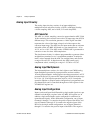
Chapter 2 Configuration and Installation
©
National Instruments Corporation 2-43 AT-MIO-16X User Manual
You can minimize noise pickup and maximize measurement accuracy
by doing the following:
• Use differential analog input connections to reject common-mode
noise.
• Use individually shielded, twisted-pair wires to connect analog
input signals to the AT-MIO-16X. With this type of wire, the
signals attached to the CH+ and CH– inputs are twisted together
and then covered with a shield. This shield is then connected only
at one point to the signal source ground. This kind of connection is
required for signals traveling through areas with large magnetic
fields or high electromagnetic interference.
• Route signals to the AT-MIO-16X carefully. Keep cabling away
from noise sources. The most common noise source in a PC data
acquisition system is the video monitor. Separate the monitor from
the analog signals as much as possible.
The following recommendations apply for all signal connections to the
AT-MIO-16X:
• Separate AT-MIO-16X signal lines from high-current or
high-voltage lines. These lines are capable of inducing currents in
or voltages on the AT-MIO-16X signal lines if they run in parallel
paths at a close distance. Reduce the magnetic coupling between
lines by separating them by a reasonable distance if they run in
parallel, or by running the lines at right angles to each other.
• Do not run AT-MIO-16X signal lines through conduits that also
contain power lines.
• Protect AT-MIO-16X signal lines from magnetic fields caused by
electric motors, welding equipment, breakers, or transformers by
running the AT-MIO-16X signal lines through special metal
conduits.
Cabling Considerations for the AT-MIO-16X with 50-Pin
I/O Connector
National Instruments has a cable termination accessory, the CB-50,
for use with the AT-MIO-16X board. This kit includes a terminated
50-conductor flat ribbon cable and a connector block. Signal I/O leads
can be attached to screw terminals on the connector block and thereby
connected to the AT-MIO-16X I/O connector.


















